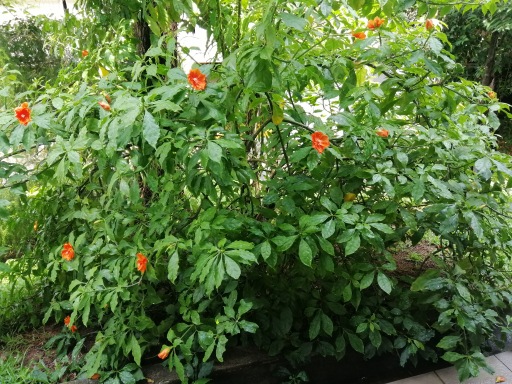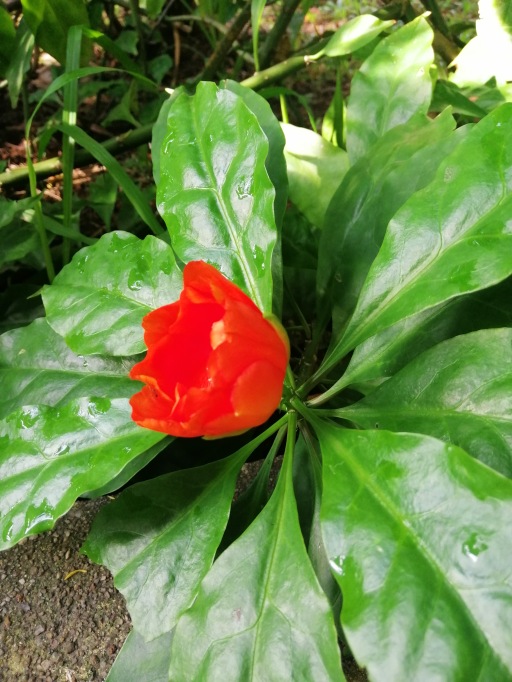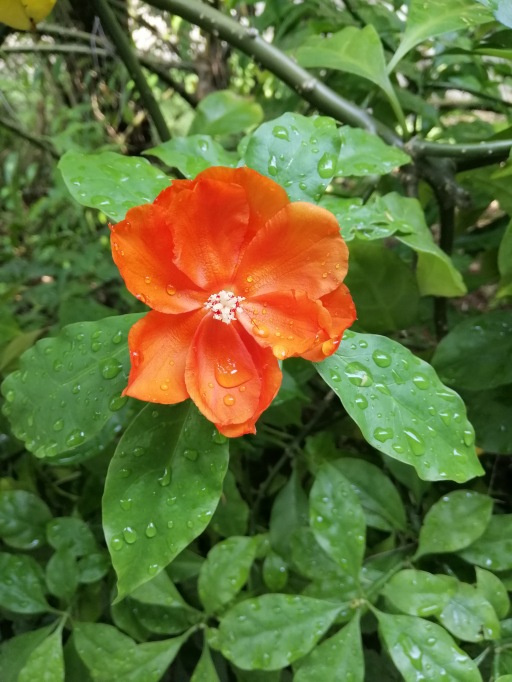In perhaps a concerted effort to shield the row of shops from the exhaust of the carpark, or just a gardening legacy of previous generations, a hodgepodge mix of plants lines the walkway at our favourite haunt. By hodgepodge, I really mean hodgepodge. There are pines, banana trees, papaya trees, lime trees, a random cluster of ginger and weeds, and this little shrub with pretty red flowers.

Bushy
The Seven Star Plant (Pereskia bleo) is also known as Rose Cactus (although other members of the genus also share that name), Bintang Tujuh, Cancer Plant and Chat Sim Chan (probably Cantonese for Qi Xing Zhen, which means seven-star needle). A member of the cactus family, it, and in fact the entire genus, is unique in that it has persistent non-succulent leaves (in other words, its leaves are not fleshy, like you would expect a succulent’s leaves to be).

Whorl of leaves topped with a partially opened bud
The Seven Star Plant has dark green leaves arranged in whorls, and distinct, reddish-orange flowers with a cluster of white stamens and stigma in the middle. Flowers last for only a day, and soon develop into conical fruit. Sharp thorns at the base of the plant give rise to its “seven-star needle” moniker, harking to its cactus-y origins.

Flower
Although native to Brazil, Paraguay, and Uruguay, it’s now widely cultivated in other parts of the world, and grows well in Singapore and Malaysia. In Malaysia, its medicinal properties have led to its deliberate cultivation. As its name suggests, it’s used to treat cancers, in particular nasal and colon cancers, as well as high blood pressure, diabetes, rheumatism, and ulcers. Leaves can be eaten raw or cooked, although I see no reports on how it tastes. Well I could technically give it a shot myself, but nope, I literally and figuratively don’t have the guts for that.

Conical fruit, reportedly yellow when ripe
Given its leaner attributes compared to other cacti, the Seven Star Plant needs to be treated with comparatively more care. It can be grown from seeds or cuttings, the latter of which should be planted immediately in moist cactus-type soil, rather than being left out to dry as you would with other cactus cuttings. It can be fertilised fortnightly with cactus fertiliser, and watered regularly during the hotter, active growing seasons. As with other cacti, it is important that the soil drains well. Although drought resistant, it wouldn’t take to dry conditions as well as succulent cacti would. Warm climates work well- I’ve never seen the one here look battered by Singapore’s constant heat and even rainy seasons- but it allegedly survives in temperatures as low as 10 degrees Celsius.



The actual scientific name of the plant is Pereskia Bleo.
LikeLike
Oh yes you’re right- let me amend that. Thanks!
LikeLike
It tastes great eaten raw, texture and taste similar to slimy san choi aka malabar spinach
LikeLike